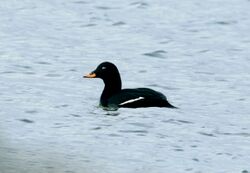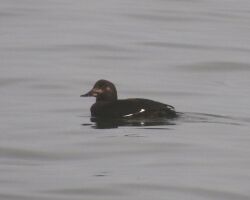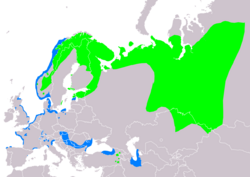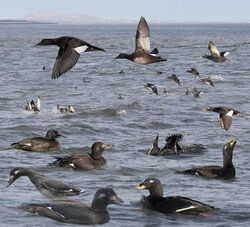Biology:Velvet scoter
| Velvet scoter | |
|---|---|

| |
| Male | |

| |
| Female | |
| Scientific classification | |
| Domain: | Eukaryota |
| Kingdom: | Animalia |
| Phylum: | Chordata |
| Class: | Aves |
| Order: | Anseriformes |
| Family: | Anatidae |
| Genus: | Melanitta |
| Subgenus: | Melanitta |
| Species: | M. fusca
|
| Binomial name | |
| Melanitta fusca | |

| |
| Range of M. fusca Breeding Non-breeding
| |
| Synonyms | |
|
Anas fusca Linnaeus, 1758 | |
The velvet scoter (Melanitta fusca), also called a velvet duck,[2] is a large sea duck, which breeds over the far north of Europe and the Palearctic west of the Yenisey basin. The genus name is derived from Ancient Greek melas "black" and netta "duck". The species name is from the Latin fuscus "dusky brown".[3]
A small, isolated population nests in eastern Turkey. Stejneger's scoter and the white-winged scoter are sometimes considered conspecific with the velvet scoter, and its two constituent subspecies are then known as M. f. stejnegeri and M. f. deglandi. Velvet, Stejneger's, and white-winged scoters, along with the surf scoter, are placed in the subgenus Melanitta, distinct from the subgenus Oidemia to which the black scoter and common scoter belong.
It winters farther south in temperate zones, Europe as far south as Great Britain, and on the Black and Caspian Sea. Small numbers reach France and northern Spain . It forms large flocks on suitable coastal waters. These are tightly packed, and the birds tend to take off together. The species is listed as Vulnerable by the IUCN.
The lined nest is built on the ground close to the sea, lakes or rivers, in woodland or tundra, and typically contains 7–9 eggs. This duck dives for crustaceans and molluscs.
It is characterised by its bulky shape and large bill. It is the largest scoter at 51–58 cm. The male is all black, except for white around the eye and a white speculum. It has a bulbous yellow bill with a black base. The females are brown birds with two pale patches on each side of the head and white wing patches.
The velvet scoter is one of the species to which the Agreement on the Conservation of African-Eurasian Migratory Waterbirds (AEWA) applies.
Velvet Scoters of the Caucasus
Lake Tabatskuri in the region of Samtskhe-Javakheti, Georgia, holds the last breeding population of velvet scoters in the Caucasus.[4] Studies into this population in 2017-2018 found 25-35 pairs at the lake, with substantially fewer nesting.
Competition for nesting locations, predation on velvet scoters by gulls, and disturbance by fishing activities were identified as contributing factors to reproductivity rates that were considered as "poor".[5]
Georgian conservationist and ornithologist, Nika Paposhvili, has led conservation efforts that have begun to ameliorate the factors hindering the scoters breeding success. A documentary film, "Mr. Velvet Scoter", was released in May 2023 documenting the work and life of Nika Paposhvili.[6]
References
- ↑ BirdLife International (2020). "Melanitta fusca". IUCN Red List of Threatened Species 2020: e.T22724836A183801134. doi:10.2305/IUCN.UK.2020-3.RLTS.T22724836A183801134.en. https://www.iucnredlist.org/species/22724836/183801134. Retrieved 12 November 2021.
- ↑ Buczacki, Stefan (2005) Fauna Britannica, Hamlyn, London.
- ↑ Jobling, James A (2010). The Helm Dictionary of Scientific Bird Names. London: Christopher Helm. pp. 167, 246. ISBN 978-1-4081-2501-4.
- ↑ "Research and conservation of the velvet scoter in Georgia" (in en-GB). https://www.conservationleadershipprogramme.org/project/velvet-scoter-duck-georgia/.
- ↑ "Research and conservation of the velvet scoter in Georgia" (in en-GB). https://www.conservationleadershipprogramme.org/project/velvet-scoter-duck-georgia/.
- ↑ Today, Georgia (2023-06-08). "Mr. Velvet Scoter (მისტერ გარიელი) – The Story of a Long Lost Caucasian Treasure" (in en-US). https://georgiatoday.ge/mr-velvet-scoter-%e1%83%9b%e1%83%98%e1%83%a1%e1%83%a2%e1%83%94%e1%83%a0-%e1%83%92%e1%83%90%e1%83%a0%e1%83%98%e1%83%94%e1%83%9a%e1%83%98-the-story-of-a-long-lost-caucasian-treasure/.
External links
| Wikimedia Commons has media related to Melanitta fusca. |
- Velvet Scoter, RSPB
Wikidata ☰ Q201300 entry
 |




